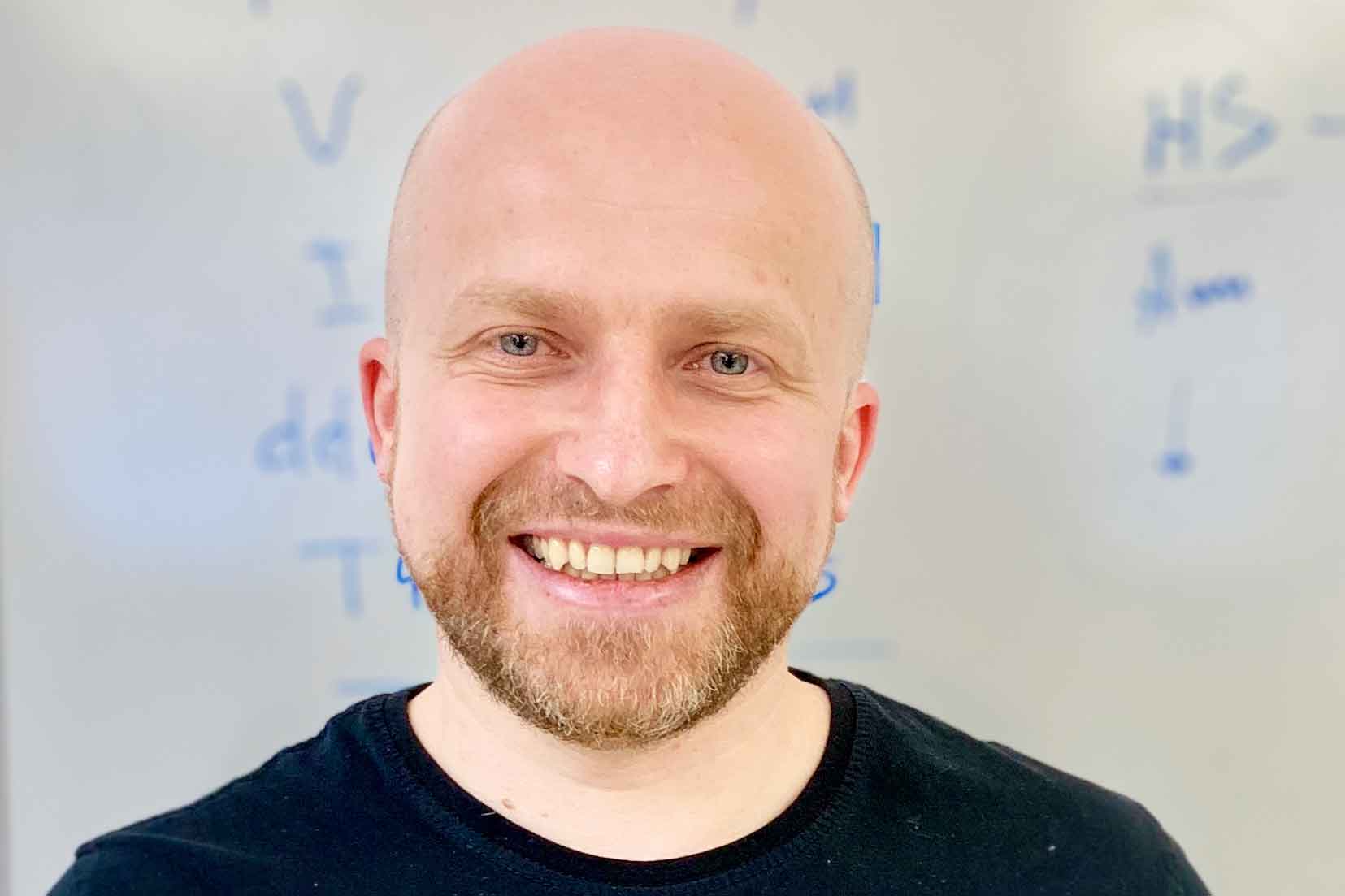Oleksandr "Alex" Shcheglovitov
Associate Professor of Neurobiology
Adjunct Associate Professor of Psychiatry and Adjunct Associate Professor of Biomedical Engineering
Affiliation with the Huntsman Cancer Institute
Human brain development, human induced pluripotent stem cells (iPSCs), iPSC-derived brain organoids, CRISPR/Cas-editing, human synapses, human neural networks

Molecular Biology Program
Education
B.S. National Technical University of Ukraine
M.S. National Technical University of Ukraine
Ph.D. Bogomoletz Institute of Physiology
Research
In the Shcheglovitov lab, our research is focused on understanding the cellular and molecular mechanisms of human cortical development under both normal and pathological conditions. To do this, we use a combination of patient-derived and CRISPR-engineered induced pluripotent stem cells (iPSCs). We produce iPSCs from easily accessible cells, such as blood or skin, that are acquired from both healthy control individuals and patients with genetic disorders. We then differentiate iPSCs into cortical neurons or three-dimensional human brain structures called ‘organoids’ in order to probe genetic abnormalities and the underlying molecular mechanisms. Using a combination of molecular biology, biochemistry, imaging, and electrophysiology techniques, we work to better understand the mechanisms underlying human-specific features of cortex development and neurodevelopmental pathologies. The ultimate goal of our research is to discover new therapies for patients with currently incurable brain disorders such as autism and drug-resistant pediatric epilepsy.
Our current efforts are primarily focused on a technology development project for studying human corticogenesis and two disease-related research projects.
Project 1: Single-Rosette derived Cortical Organoids for investigating human-specific aspects of cortical development and function.
We have developed a new method for generating cortical organoids from a single iPSC-derived neural rosette. Single-Rosette derived Cortical Organoids (SRCOs) grow large in suspension culture, reaching 4-5 mm in diameter by four months while maintaining a single internal lumen (ventricle-like structure). SRCOs consist of different neuronal cell types, including cortical neural progenitors, deep and superficial cortical excitatory neurons, inhibitory neurons, astrocytes, oligodendrocytes, and pericytes in three-dimensional organization around the lumen. The goal of this project is to unbiasedly characterize the molecular identities, developmental trajectories, and physiological properties of cells in SRCOs using single-cell RNA-sequencing, bioinformatics, and electrophysiology.
Project 2: Cellular and molecular mechanisms disrupted in 22q13 deletion syndrome and autism
Mutations in genes encoding synaptic proteins and impaired functional brain connectivity are emerging as common deficits associated with autism spectrum disorders (ASDs). However, how mutated synaptic proteins affect the properties of human neurons at the cellular and molecular levels to cause abnormal brain connections remains an important unanswered question. Addressing this question is essential for understanding the etiology and pathology of ASDs and developing novel therapeutic strategies for patients. We previously demonstrated that SHANK3-deficient iPSC-derived cortical neurons, generated from 22q13 deletion syndrome patients with autism, have severely impaired intrinsic excitability and excitatory synaptic transmission (Shcheglovitov et al. Nature 2013). However, how these two phenotypes develop and affect neuronal connectivity in the brain remain unknown. The goal of this project is to elucidate the cellular and molecular mechanisms responsible for the development of synaptic and connectivity deficits in SHANK3-deficient human neurons.
References
- Wang et. al., (2021) “Modeling autism-associated SHANK3 deficiency using human cortico-striatal organoids generated from single neural rosettes”BioRxiv doi: https://doi.org/10.1101/2021.01.25.428022
- Chiola, Napan, Wang et al., (2021) “Defective AMPA-mediated synaptic transmission and morphology in human neurons with hemizygous SHANK3 deletion engrafted in mouse prefrontal cortex” Mol Psychiatry https://doi.org/10.1038/s41380-021-01023-2
- Chiola et., (2021) “iPSC toolbox for understanding and repairing disrupted brain circuits in autism” Mol Psychiatry https://www.nature.com/articles/s41380-021-01288-7
- Byers B, Lee HJ, Liu J, Weitz AJ, Lin P, Zhang P, Shcheglovitov A, Dolmetsch R, Pera RR, Lee JH (2015) "Direct in vivo assessment of human stem cell graft-host neural circuits."Neuroimage 114:328-37
- *Eckle VS, *Shcheglovitov A, *Vitko I, Dey D, Yap CC, Winckler B, Perez-Reyes E (2014) “Mechanisms by which CACNA1H mutations found in epilepsy patients increase seizure susceptibility” Journal of Physiology592(Pt 4):795-809 (*equally contributed authors)
- Shcheglovitov A et al., (2013)“Shank3 and IGF1 Restore Synaptic Deficits in Neurons from 22q13 Deletion Syndrome Patients”Nature https://www.nature.com/articles/nature12618
- Shcheglovitov A, Shcheglovitova O, Yazawa M, Portmann T, Shu R, Sebastiano V, Krawisz A, Froehlich W, Bernstein JA, Hallmayer J, Dolmetsch RE (2013) “Shank3 and IGF1 Restore Synaptic Deficits in Neurons from 22q13 Deletion Syndrome Patients” Nature 503(7475):267-71. Featured in: Cell (Dec 13, 2013); Faculty of 1000
- Krey JF, Paşca SP, Shcheglovitov A, Yazawa M, Schwemberger R, Rasmusson R, Dolmetsch RE (2012) “Timothy syndrome is associated with activity-dependent dendritic retraction in rodent and human neurons” Nature Neuroscience 16(2):201-9
- *Shcheglovitov A, Vitko I, Lazarenko R, Orestes P, Todorovic SM, *Perez-Reyes E (2012) “Molecular and biophysical basis of glutamate and trace metal modulation of voltage-gated Cav2.3 calcium channels” Journal of General Physiology 139(3):219-34 (*corresponding authors)
- Paşca SP, Portmann T, Voineagu I, Yazawa M, Shcheglovitov A, Paşca AM, Cord B, Palmer TD, Chikahisa S, Seiji N, Bernstein JA, Hallmayer J, Geschwind DH, Dolmetsch RE (2011) “Using iPS cell-derived neurons to uncover cellular phenotypes in patients with Timothy Syndrome” Nature Medicine 17(12):1657-62. Featured in: Nat Med (Dec 6, 2011); Nat Rev Neurosci (Dec 20, 2011); Faculty of 1000
- *Yoo AS, *Sun AX, *Li L, *Shcheglovitov A, Portmann T, Li Y, Lee-Messer C, Dolmetsch RE, Tsien RW, Crabtree GR (2011) “MicroRNA-Mediated Conversion of Human Fibroblasts to Neurons” Nature 476(7359):228-31 (*equally contributed authors). Featured in: Nature 476 (7359); Faculty of 1000
- Nguyen HN, Byers B, Cord B, Shcheglovitov A, Byrne J, Gujar P, Kee K, Schüle B, Dolmetsch RE, Langston W, Palmer TD, Reijo-Pera R (2011) “LRRK2 mutant iPSC-derived DA neurons demonstrate increased susceptibility to oxidative stress” Cell Stem Cell 8(3): 267-80
- Park CY, Shcheglovitov A, Dolmetsch R (2010) “The CRAC channel activator STIM1 binds and inhibits L-type voltage-gated calcium channels” Science 330(6000): 101-5. Featured in: Science 330(6000); Faculty of 1000
